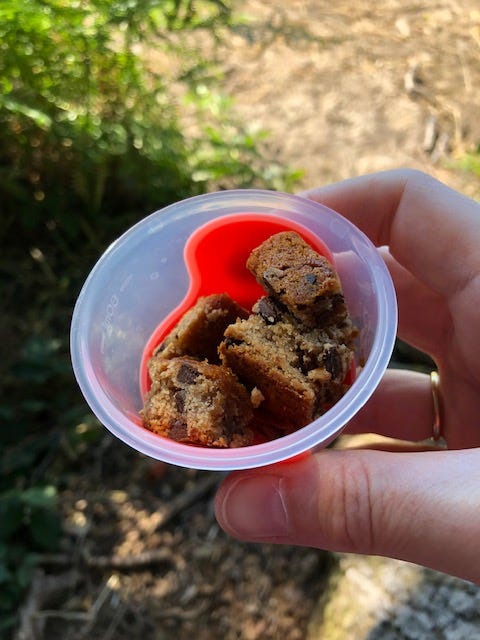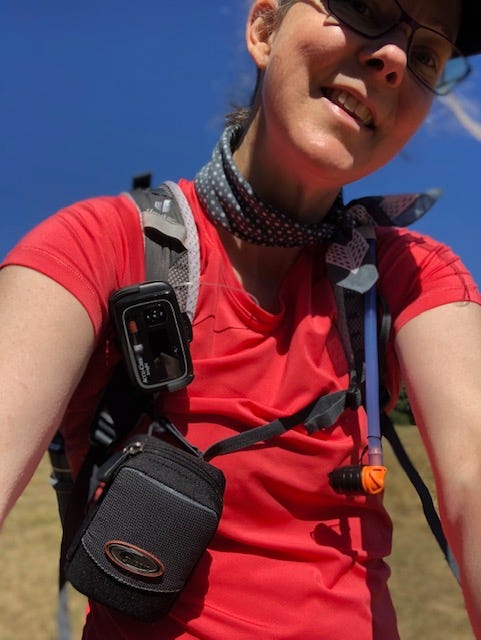17. Vulnerability, and why it takes me so long to leave the house
When the comfort zone isn't all that comfy.
Dear Reader,
For a while now I’ve been wanting to write about the thing that often feels like it’s not only my full-time job but the worst job anyone’s ever had. I’ve had some humdingers of awful jobs, so I’ll call myself qualified.
And connected with this, some things have come together in the past week which have led me to explore some thoughts around vulnerability and what it means for me to step out of my comfort zone.
Last week I received a delightful comment from Mark Fyve, on 16. Taking the pressure off:
‘I enjoy reading about how you constantly venture outside your comfort zone not because you need to but because you – want – to. Keep at it!’
This was lovely to read. Thinking about it, my comfort zone had become far too comfortable over the last few years. In the Covid lockdowns my PPE of choice was my own front door: in fact in April 2020 I did not leave home once.
I’ve always needed to feel safe. For me, safety and security are in my home, with everything I need – the comfortable and the uncomfortable – at my fingertips. Typically I have always – grudgingly – preferred constrained horizons to broad ones.
So why ‘grudgingly’, and what is it that I need at my fingertips?
Reader, I need my stuff. A type 1 diabetes diagnosis is the dubious gateway to accruing a vast number of – what shall we call them? – accessories. In the early days after mine – in 1986, when I was eleven – these were vials of insulin, syringes, alcohol swabs, lancets (horrid sharp things for sampling blood from fingertips), read-by-eye reagent strips and a billowing cloud of cotton wool that I was told I would need to carry around with me at all times. Glucose tablets and sugary snacks would cascade out of my overfilled just-in-case pockets.
Once my parents had saved up enough money to buy one, I acquired a blood glucose meter the approximate size and weight of a house brick. Apparently, owning this expensive-for-the-time tech should have made me the envy of every other pre-teen diabetic, but, not knowing any others, and of course feeling like the ONLY ONE IN THE WORLD WITH THIS AWFUL CONDITION, I would seethe at the evil brick and everything it stood for.
The meter would take two and a half minutes to elicit a reading. It was loud: beep beep BEEP to let you know a minute had passed so it was time to wipe the blood off the test strip, then beep beep BEEP again to tell me to push the strip face down into the slot in the meter, and finally a very long BEEEEEEEP for the result.
Fast-forward three and a half decades and the accessories, although not bougie, are at least bijou. My current meter is a fraction of the size of the 1980s monster and gives me a result in around six seconds, no wiping required – bye bye, cotton wool. And its beep is turn-offable.
I graduated from syringes to refillable insulin pens (syringes with street cred) in 1989, then to more convenient disposable pens in the early 2000s. My insulin pump superseded anything syringe-y in 2015, its method of delivery being a lengthy hosepipe into a cannula under my skin.

I very rarely use my blood meter. Instead I have a flash glucose monitor, with a little sensor in my arm which I scan to get a reading. I call the little electronic reader my ‘bipper’. Its convenient, compact size makes it a nightmare to find in most circumstances, and I love and hate this thing in equal measure.



Glucose tablets and sugary snacks still spill from my pockets.
‘What?’ I hear you say. ‘Surely you want to avoid sugar if you’re diabetic?’
Yes and no.
Yes because type 1 diabetes is a condition of high blood glucose (hyperglycaemia) directly caused by a lack of insulin. Sugar (indeed, any carbohydrate) will raise it in a heartbeat.
And no because the treatment of type 1 diabetes – the injection or infusion of insulin – can cause low blood glucose (hypoglycaemia) which in turn requires treatment with….. SUGAR.
Now, no medication side effect is ever going to be a happy affair, but when the treatment for your condition can cause an equal and opposite rollercoaster reaction requiring treatment with the very stuff that your body can’t deal with, potentially multiple times a day – well, you can see that that’s a tricky path to navigate.
In 2014 I wrote a very bleak essay about all the reasons I was struggling to live with diabetes and how I was dangerously obsessed with keeping my blood glucose readings between 4mmol/l and 7mmol/l at all times. At the time I was 39, and had had the condition for 28 years. You don’t get loyalty points for this stuff. No badge. No trophy.
And absolutely no days off.
I called my essay ‘Between Two Lines’, and presented it to my team at the hospital to support my desperate and hitherto futile attempt to gain access to an insulin pump.
It took some time, but it worked. I’ve now been using an insulin pump since 2015, and it’s made a huge difference. ‘Between Two Lines’ has since been shared with other diabetes patients and even used in nurse training at my local healthcare trust.
I had been going to share it with you to put this essay into context. But what I’ve said above covers the gist in way more palatable terms than the depressing, angst-ridden verbiage I’d slammed onto the desk at the hospital eight years ago.
Reader, I’m sparing you the trauma. Suffice it to say that I wasn’t in a good place for a while back then.
(You’re welcome.)
These days, though, I’m thriving.
Since discovering my love for walking I’ve had to find ways to accommodate my diabetes accessories. A recent acquisition for my shorter walks is a tiny rucksack with day-glo straps, and I am thrilled that I can pile my entire life-support system into its main pouch and two capacious pockets on the straps.
When I first put it on, with diabetes management gadgetry on full show clipped to both straps, my husband and I agreed I looked more like a Police Community Support Officer or an over-accessorised council employee than a sensible type 1 diabetic out for a stroll.
Police radio? No, that’s my bipper.
Body camera, with cabling snaking down the inside of my t-shirt? No, that’s my pump, and that ‘cabling’ is a narrow hosepipe delivering lifesaving insulin.
To be honest, after the PCSO giggle I can’t really take myself seriously with the tiny day-glo number, and most of the time I take my bigger rucksack out with me. This one can accommodate everything I need in the diabetes management line, plus three litres of water, wet weather gear, a map I can’t read, the compass I can’t use, and probably an entire picnic hamper complete with portable coffee machine if I put my mind to it.

Whether I’m going to work, out on a walk or just out out, I have a system to remind me to take everything I need. Passport, tickets, money this ain’t – no summer holiday checklist here. It’s more a case of ‘what do I need to take with me so I’m safe and not going to make a fool of myself for being low/high/dead while I’m out of the house?’
Reader – in case you don’t already know it from my previous posts – I’m a scatterbrain. My memory is far more selective than I’d like it to be.
Pre-walk, things look rather like this:
My bipper’s in my pocket, but my glucose tablets are on the sideboard.
My water bladder’s in my rucksack, but my two tubs of snacks are at the bottom of the stairs.
My packed lunch is still in the fridge…
My minimum count of false-start departures is three. I’ve even been known – and this has happened twice, believe it or not – to set off down the lane in carpet slippers rather than walking boots. Not joking.
(Yes, there is a checklist by the front door. And one day I’ll start to pay it more attention. One day.)
Inconvenient as it may be, a diagnosis of type 1 diabetes is no longer the death sentence it had been before the discovery of insulin a hundred years ago. In fact, sometimes it’s not even unstraightforward to manage, and I have always had the promise of a long and healthy life ahead of me, provided I follow the advice I need to heed in order to protect myself from the alarming and tragic complications of uncontrolled diabetes I all too often read about in the news.
I am constantly aware that my type 1 diabetes has the potential to turn some everyday things into high risk activities: eating, drinking and exercise (even just walking) are all factors needing meticulous attention to detail. In one of my more thoughtful moments I might conclude that with my walking routine I’m not only exploring my propensity to get lost but also my ability to survive in a world where I feel so vulnerable.
My 15km walk this morning took me through a meadow where I watched some beautiful mauve and blue butterflies fluttering around energetically, resting at regular intervals to feed on flower nectar. These tiny insects with beautiful wings thinner than paper look so fragile, so ethereal, and like me they have a frequent need to rest and refuel.
Like mine, to stay alive, their busy routine is relentless and exhausting.
And like me, as Mark was encouraging me to do in his comment last week, these bad-ass creatures keep at it.
We have to. We know no different.
Reader, there is strength even where there is vulnerability.
And great comfort can be found by stepping out of a comfort zone.
Now, has anyone seen my phone…..?
Love,
Rebecca
If you enjoyed this post, please let me know by clicking the heart. Thank you!
What can’t you leave the house without? And have you ever left the house for the day wearing slippers? Please tell me I’m not the only one!
Thank you for reading! If you enjoy ‘Dear Reader, I’m lost’, please share and subscribe for free.



Rebecca, My sister was diagnosed with Type 1 Diabetes when she was 12 and I was 6. She was born long before you--and the treatment has advanced markedly. You and she are testaments to resilience. You are like that butterfly: The unheard move of that delicate wing whispers on the wind. It ripples and is heard somewhere else.
Wonderful piece. I'm glad technology is contributing to your quality of life.
As for me you guesses it, I've got to have some pen and paper with me.